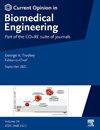基于niosome的透皮给药系统的最新进展
IF 4.2
3区 工程技术
Q2 ENGINEERING, BIOMEDICAL
引用次数: 0
摘要
纳米粒是一种很有前途的经皮给药纳米系统。它们在药物递送和靶向应用方面具有几个优点(即生物相容性,增加的物理稳定性,修饰的药物释放特性,低成本和易于扩大规模)。此外,它们被认为是有利的候选者,因为它们具有增强皮肤渗透的能力,这是经皮给药的主要挑战。这篇综述的目的是从一个关键的角度来总结最新的基于纳米粒的透皮给药配方及其在制药技术和工程中的附加价值。讨论和分析了niosomes基透皮给药系统的配方方案、主要赋形剂和活性药物成分,以及主要的理化生物学特性和应用。考虑到它们在制药工业中的规模扩大,对关键质量属性(cqa)以及最关键的设计和工艺参数进行了深入审查,同时也考虑了现有的限制。Niosomes是候选的药物传递平台,在经皮给药中具有附加价值。本文章由计算机程序翻译,如有差异,请以英文原文为准。

Recent advances in niosome-based transdermal drug delivery systems
Niosomes are promising drug delivery nanosystems for transdermal administration. They exhibit several advantages for drug delivery and targeting applications, (i.e. biocompatibility, increased physical stability, modified drug release properties, low cost, and easy scale-up). Additionally, they are deemed as favorable candidates caused by their capability to enhance skin permeation, which is the main challenge in transcutaneous delivery. The aim of this review is to summarize from a critical point of view the most recent niosome-based nanoparticulate formulations for transdermal administration and their added value in pharmaceutical technology and engineering. The formulation protocols, the main excipients and Active Pharmaceutical Ingredients (APIs), and the main physicochemical and biological properties and applications of niosome-based transdermal drug delivery systems are discussed and analyzed. Taking into account their scale-up in the pharmaceutical industry, the critical quality attributes (CQAs), along with the most critical design and process parameters, are reviewed in depth, while existing limitations are also considered. Niosomes are candidate drug delivery platforms with added value in transdermal administration.
求助全文
通过发布文献求助,成功后即可免费获取论文全文。
去求助
来源期刊

Current Opinion in Biomedical Engineering
Medicine-Medicine (miscellaneous)
CiteScore
8.60
自引率
2.60%
发文量
59
 求助内容:
求助内容: 应助结果提醒方式:
应助结果提醒方式:


